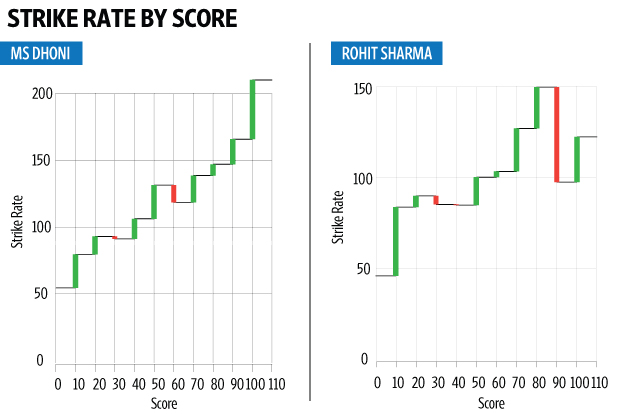Back in MS Dhoni’s heyday, CSK fans would rave about his strategy that they called as “taking it deep”. The idea was that while chasing a target, Dhoni would initially bat steadily, getting sort of close but increasing the required run rate. And then when it seemed to be getting out of hand, he would start belting, taking the bowlers by surprise and his team to victory.
This happened many times to be recognised by fans as a consistent strategy. Initially it didn’t make sense to me – why was it that he would purposely decrease the average chances of his team’s victory so that he could take them to a heroic chase?
But then, thinking about it, the strategy seems fair – he would never do this in a comfortable chase (where the chase was “in the money”). This would happen only in steep (out of the money) chases. And his idea of “taking it deep” was in terms of increasing the volatility.
Everyone knows that when your option is out of the money, volatility is good for you. Which means an increase in volatility will increase the value of the option.
And that is exactly what Dhoni would do. Keep wickets and let the required rate increase, which would basically increase volatility. And then rely on “mental strength” and “functioning under pressure” to win. It didn’t always succeed, of course (and that it didn’t always fail meant Dhoni wouldn’t come off badly when it failed). However, it was a very good gamble.
We see this kind of a gamble often in chess as well. When a player has a slightly inferior position, he/she decides to increase chances by “mixing it up a bit”. Usually that involves a piece or an exchange sacrifice, in the hope of complicating the position, or creating an imbalance. This, once again, increases volatility, which means increases the chances for the player with the slightly inferior position.
And in the ongoing World Cup, we have seen Japan follow this kind of strategy in football as well. It worked well in games against Germany and Spain, which were a priori better teams than Japan.
In both games, Japan started with a conservative lineup, hoping to keep it tight in the first half and go into half time either level or only one goal behind. And then at half time, they would bring on a couple of fast and tricky players – Ritsu Doan and Kaoru Mitoma. Basically increasing the volatility against an already tired opposition.
And then these high volatility players would do their bit, and as it happened in both games, Japan came back from 0-1 at half time to win 2-1. Basically, having “taken the game deep”, they would go helter skelter (I was conscious to not say “hara kiri” here, since it wasn’t really suicidal). And hit the opposition quickly, and on the break.
Surprisingly, they didn’t follow the same strategy against Croatia, in the pre-quarterfinal, where Doan started the game, and Mitoma came on only in the 64th minute. Maybe they reasoned that Croatia weren’t that much better than them, and so the option wasn’t out of the money enough to increase volatility through the game. As it happened, the game went to penalties (basically deeper than Japan’s usual strategy) where Croatia prevailed.
The difference between Dhoni and Japan is that in Japan’s case, the players who increase the volatility and those who then take advantage are different. In Dhoni’s case, he performs both functions – he first bats steadily to increase vol, and then goes bonkers himself!


